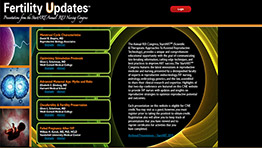FertilityUpdates.com
Fertility UpdatesSM Presentations from the 2019 StartARTSM Annual REI Nursing Congress
Archived, for viewing purposes only.
Purpose
This online educational activity offer selected presentations from the Annual REI Nursing Congress: Scientific & Therapeutic Approaches To Assisted Reproductive Technology (StartART
SM), providing a unique and comprehensive educational opportunity for IVF nurses. The online activity, like the Congress, features critical updates on the latest advances in reproductive medicine from procedures and protocols to genetics, bioethical and legal issues. The purpose of this program, encompassing both live and enduring presentations, is to provide late-breaking information, cutting-edge techniques, and best practices to improve ART outcomes. The learning experience is enhanced by the unique contributions that IVF nurses make to the field of reproductive medicine through their skills, compassion, and caring.
Learning Objectives
After participating in this online educational activity, the learner should be able to:
- Explain the challenges and management issues associated with advanced parental age;
- Identify women at risk in order to initiate interventions, and potentially improve pregnancy, neonatal and long‐term health;
- Gain knowledge of the physiology of the protein and steroid hormones involved in human reproduction that allows clinicians the ability to manipulate ovarian function in ways that benefit infertile couples
- Review the pharmacological preparations containing either recombinant or urinary FSH used to induce superovulation for IVF or intrauterine insemination
- Recognize the GnRH physiology that has allowed clinicians to control ovarian stimulation better and improve outcomes in IVF-embryo transfer
- Critically evaluate the data comparing different types of endometrial preparation cycles – natural – artificial – letrozole
- Distinguish strategies for selecting stimulation protocols according to responder types to optimize outcomes;
- Assess the data surrounding the different types of estrogen and progesterone used for luteal phase support
- Review guidelines regarding fertility preservation
- Assess the effect of treatments on ovarian reserve
- Discuss current fertility preservation options
- Evaluate success rates for: Oocyte cryopreservation, embryo cryopreservation; ovarian tissue cryopreservation
- Describe novel protocols for random start stimulations
- Apply guidelines and algorithms to improve recurrent pregnancy loss;
Agenda
Faculty
Next Activity
